Houxing Ren
Probability-Consistent Preference Optimization for Enhanced LLM Reasoning
May 29, 2025Abstract:Recent advances in preference optimization have demonstrated significant potential for improving mathematical reasoning capabilities in large language models (LLMs). While current approaches leverage high-quality pairwise preference data through outcome-based criteria like answer correctness or consistency, they fundamentally neglect the internal logical coherence of responses. To overcome this, we propose Probability-Consistent Preference Optimization (PCPO), a novel framework that establishes dual quantitative metrics for preference selection: (1) surface-level answer correctness and (2) intrinsic token-level probability consistency across responses. Extensive experiments show that our PCPO consistently outperforms existing outcome-only criterion approaches across a diverse range of LLMs and benchmarks. Our code is publicly available at https://github.com/YunqiaoYang/PCPO.
MathCoder-VL: Bridging Vision and Code for Enhanced Multimodal Mathematical Reasoning
May 15, 2025Abstract:Natural language image-caption datasets, widely used for training Large Multimodal Models, mainly focus on natural scenarios and overlook the intricate details of mathematical figures that are critical for problem-solving, hindering the advancement of current LMMs in multimodal mathematical reasoning. To this end, we propose leveraging code as supervision for cross-modal alignment, since code inherently encodes all information needed to generate corresponding figures, establishing a precise connection between the two modalities. Specifically, we co-develop our image-to-code model and dataset with model-in-the-loop approach, resulting in an image-to-code model, FigCodifier and ImgCode-8.6M dataset, the largest image-code dataset to date. Furthermore, we utilize FigCodifier to synthesize novel mathematical figures and then construct MM-MathInstruct-3M, a high-quality multimodal math instruction fine-tuning dataset. Finally, we present MathCoder-VL, trained with ImgCode-8.6M for cross-modal alignment and subsequently fine-tuned on MM-MathInstruct-3M for multimodal math problem solving. Our model achieves a new open-source SOTA across all six metrics. Notably, it surpasses GPT-4o and Claude 3.5 Sonnet in the geometry problem-solving subset of MathVista, achieving improvements of 8.9% and 9.2%. The dataset and models will be released at https://github.com/mathllm/MathCoder.
WebGen-Bench: Evaluating LLMs on Generating Interactive and Functional Websites from Scratch
May 06, 2025Abstract:LLM-based agents have demonstrated great potential in generating and managing code within complex codebases. In this paper, we introduce WebGen-Bench, a novel benchmark designed to measure an LLM-based agent's ability to create multi-file website codebases from scratch. It contains diverse instructions for website generation, created through the combined efforts of human annotators and GPT-4o. These instructions span three major categories and thirteen minor categories, encompassing nearly all important types of web applications. To assess the quality of the generated websites, we use GPT-4o to generate test cases targeting each functionality described in the instructions, and then manually filter, adjust, and organize them to ensure accuracy, resulting in 647 test cases. Each test case specifies an operation to be performed on the website and the expected result after the operation. To automate testing and improve reproducibility, we employ a powerful web-navigation agent to execute tests on the generated websites and determine whether the observed responses align with the expected results. We evaluate three high-performance code-agent frameworks, Bolt.diy, OpenHands, and Aider, using multiple proprietary and open-source LLMs as engines. The best-performing combination, Bolt.diy powered by DeepSeek-R1, achieves only 27.8\% accuracy on the test cases, highlighting the challenging nature of our benchmark. Additionally, we construct WebGen-Instruct, a training set consisting of 6,667 website-generation instructions. Training Qwen2.5-Coder-32B-Instruct on Bolt.diy trajectories generated from a subset of this training set achieves an accuracy of 38.2\%, surpassing the performance of the best proprietary model.
MathCoder2: Better Math Reasoning from Continued Pretraining on Model-translated Mathematical Code
Oct 10, 2024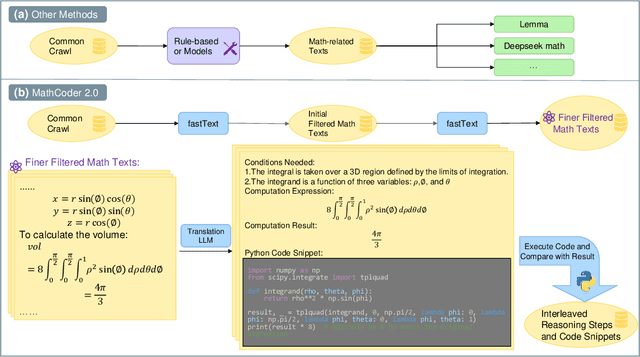

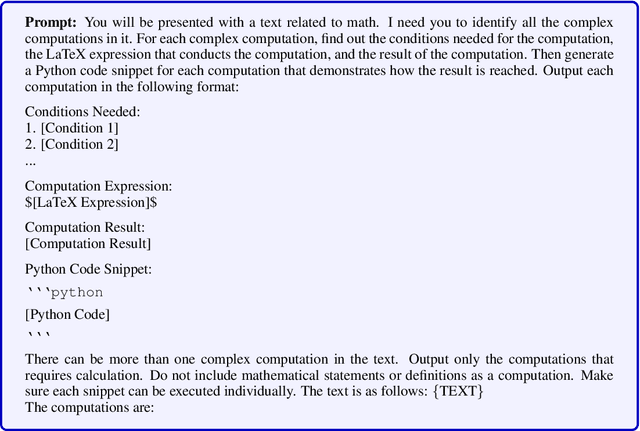
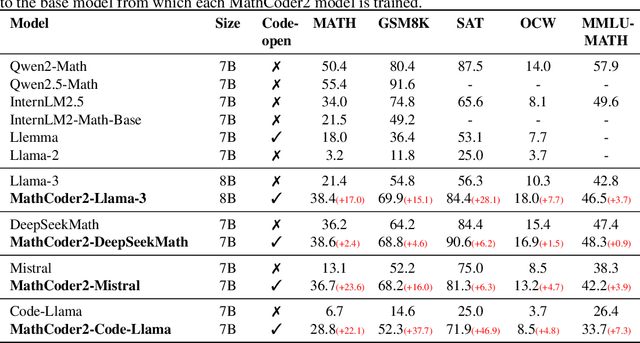
Abstract:Code has been shown to be effective in enhancing the mathematical reasoning abilities of large language models due to its precision and accuracy. Previous works involving continued mathematical pretraining often include code that utilizes math-related packages, which are primarily designed for fields such as engineering, machine learning, signal processing, or module testing, rather than being directly focused on mathematical reasoning. In this paper, we introduce a novel method for generating mathematical code accompanied with corresponding reasoning steps for continued pretraining. Our approach begins with the construction of a high-quality mathematical continued pretraining dataset by incorporating math-related web data, code using mathematical packages, math textbooks, and synthetic data. Next, we construct reasoning steps by extracting LaTeX expressions, the conditions needed for the expressions, and the results of the expressions from the previously collected dataset. Based on this extracted information, we generate corresponding code to accurately capture the mathematical reasoning process. Appending the generated code to each reasoning step results in data consisting of paired natural language reasoning steps and their corresponding code. Combining this data with the original dataset results in a 19.2B-token high-performing mathematical pretraining corpus, which we name MathCode-Pile. Training several popular base models with this corpus significantly improves their mathematical abilities, leading to the creation of the MathCoder2 family of models. All of our data processing and training code is open-sourced, ensuring full transparency and easy reproducibility of the entire data collection and training pipeline. The code is released at https://github.com/mathllm/MathCoder2 .
Step-Controlled DPO: Leveraging Stepwise Error for Enhanced Mathematical Reasoning
Jul 02, 2024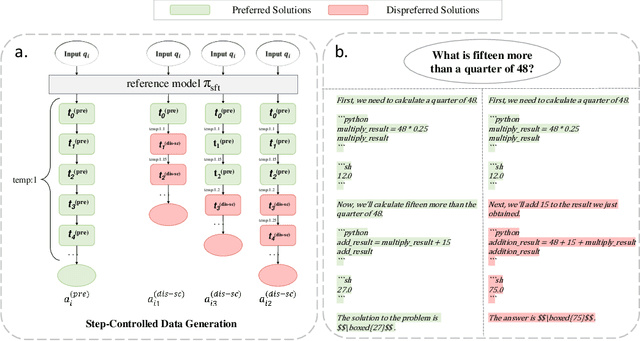
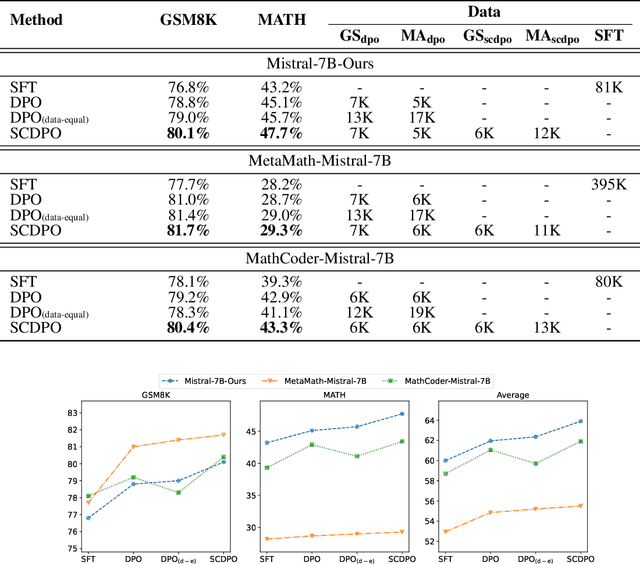

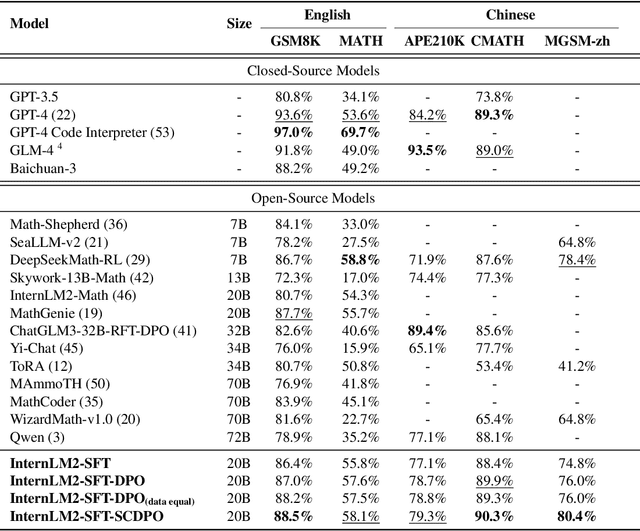
Abstract:Direct Preference Optimization (DPO) has proven effective at improving the performance of large language models (LLMs) on downstream tasks such as reasoning and alignment. In this work, we propose Step-Controlled DPO (SCDPO), a method for automatically providing stepwise error supervision by creating negative samples of mathematical reasoning rationales that start making errors at a specified step. By applying these samples in DPO training, SCDPO can better align the model to understand reasoning errors and output accurate reasoning steps. We apply SCDPO to both code-integrated and chain-of-thought solutions, empirically showing that it consistently improves the performance compared to naive DPO on three different SFT models, including one existing SFT model and two models we finetuned. Qualitative analysis of the credit assignment of SCDPO and DPO demonstrates the effectiveness of SCDPO at identifying errors in mathematical solutions. We then apply SCDPO to an InternLM2-20B model, resulting in a 20B model that achieves high scores of 88.5% on GSM8K and 58.1% on MATH, rivaling all other open-source LLMs, showing the great potential of our method.
Empowering Character-level Text Infilling by Eliminating Sub-Tokens
May 27, 2024



Abstract:In infilling tasks, sub-tokens, representing instances where a complete token is segmented into two parts, often emerge at the boundaries of prefixes, middles, and suffixes. Traditional methods focused on training models at the token level, leading to sub-optimal performance in character-level infilling tasks during the inference stage. Alternately, some approaches considered character-level infilling, but they relied on predicting sub-tokens in inference, yet this strategy diminished ability in character-level infilling tasks due to the large perplexity of the model on sub-tokens. In this paper, we introduce FIM-SE, which stands for Fill-In-the-Middle with both Starting and Ending character constraints. The proposed method addresses character-level infilling tasks by utilizing a line-level format to avoid predicting any sub-token in inference. In addition, we incorporate two special tokens to signify the rest of the incomplete lines, thereby enhancing generation guidance. Extensive experiments demonstrate that our proposed approach surpasses previous methods, offering a significant advantage. Code is available at https://github.com/SenseLLM/FIM-SE.
ReflectionCoder: Learning from Reflection Sequence for Enhanced One-off Code Generation
May 27, 2024



Abstract:Code generation plays a crucial role in various tasks, such as code auto-completion and mathematical reasoning. Previous work has proposed numerous methods to enhance code generation performance, including integrating feedback from the compiler. Inspired by this, we present ReflectionCoder, a novel approach that effectively leverages reflection sequences constructed by integrating compiler feedback to improve one-off code generation performance. Furthermore, we propose reflection self-distillation and dynamically masked distillation to effectively utilize these reflection sequences. Extensive experiments on three benchmarks, i.e., HumanEval (+), MBPP (+), and MultiPl-E, demonstrate that models fine-tuned with our method achieve state-of-the-art performance. Notably, ReflectionCoder-DeepSeek-Coder-33B reaches pass@1 of 82.9 (76.8) on HumanEval (+) and 84.1 (72.0) on MBPP (+), on par with GPT-3.5-Turbo and Claude-3-opus, and surpasses early GPT-4. Beyond the code domain, we believe this approach can benefit other domains that focus on final results and require long reasoning paths. Code and data are available at https://github.com/SenseLLM/ReflectionCoder.
MathGenie: Generating Synthetic Data with Question Back-translation for Enhancing Mathematical Reasoning of LLMs
Feb 26, 2024Abstract:Large language models (LLMs) have exhibited great potential in mathematical reasoning. However, there remains a performance gap in this area between existing open-source models and closed-source models such as GPT-4. In this paper, we introduce MathGenie, a novel method for generating diverse and reliable math problems from a small-scale problem-solution dataset (denoted as seed data). We augment the ground-truth solutions of our seed data and train a back-translation model to translate the augmented solutions back into new questions. Subsequently, we generate code-integrated solutions for the new questions. To ensure the correctness of the code-integrated solutions, we employ rationale-based strategy for solution verification. Various pretrained models, ranging from 7B to 70B, are trained on the newly curated data to test the effectiveness of the proposed augmentation technique, resulting in a family of models known as MathGenieLM. These models consistently outperform previous open-source models across five representative mathematical reasoning datasets, achieving state-of-the-art performance. In particular, MathGenieLM-InternLM2 achieves an accuracy of 87.7% on GSM8K and 55.7% on MATH, securing the best overall score among open-source language models.
MathCoder: Seamless Code Integration in LLMs for Enhanced Mathematical Reasoning
Oct 05, 2023
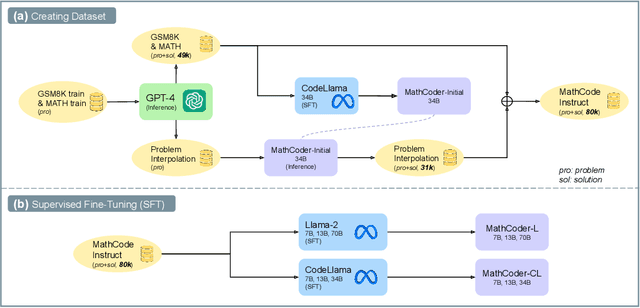
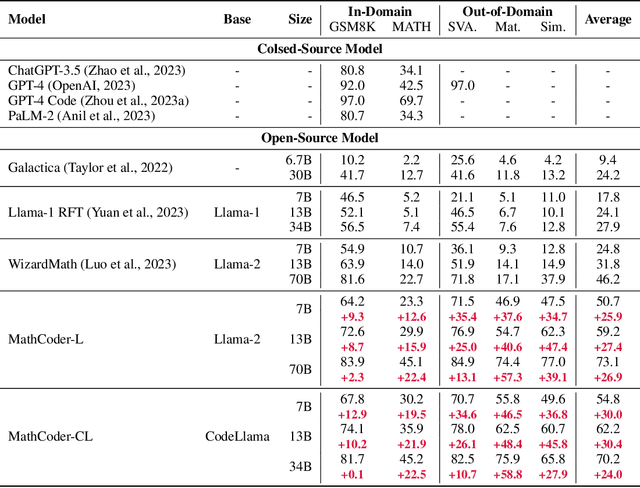
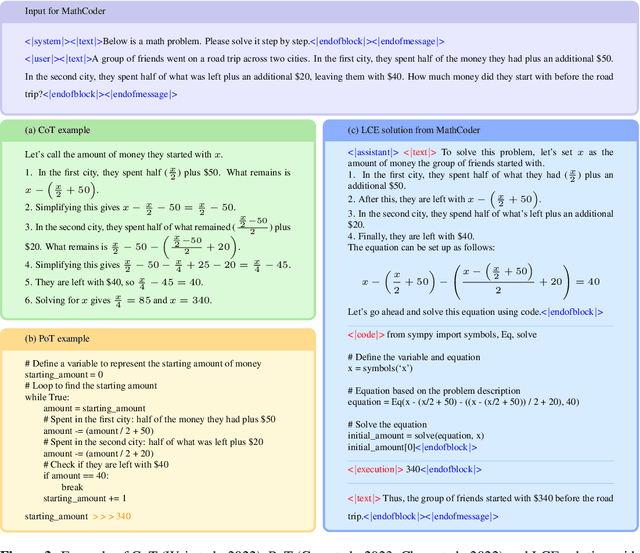
Abstract:The recently released GPT-4 Code Interpreter has demonstrated remarkable proficiency in solving challenging math problems, primarily attributed to its ability to seamlessly reason with natural language, generate code, execute code, and continue reasoning based on the execution output. In this paper, we present a method to fine-tune open-source language models, enabling them to use code for modeling and deriving math equations and, consequently, enhancing their mathematical reasoning abilities. We propose a method of generating novel and high-quality datasets with math problems and their code-based solutions, referred to as MathCodeInstruct. Each solution interleaves natural language, code, and execution results. We also introduce a customized supervised fine-tuning and inference approach. This approach yields the MathCoder models, a family of models capable of generating code-based solutions for solving challenging math problems. Impressively, the MathCoder models achieve state-of-the-art scores among open-source LLMs on the MATH (45.2%) and GSM8K (83.9%) datasets, substantially outperforming other open-source alternatives. Notably, the MathCoder model not only surpasses ChatGPT-3.5 and PaLM-2 on GSM8K and MATH but also outperforms GPT-4 on the competition-level MATH dataset. The dataset and models will be released at https://github.com/mathllm/MathCoder.
Typos-aware Bottlenecked Pre-Training for Robust Dense Retrieval
Apr 17, 2023Abstract:Current dense retrievers (DRs) are limited in their ability to effectively process misspelled queries, which constitute a significant portion of query traffic in commercial search engines. The main issue is that the pre-trained language model-based encoders used by DRs are typically trained and fine-tuned using clean, well-curated text data. Misspelled queries are typically not found in the data used for training these models, and thus misspelled queries observed at inference time are out-of-distribution compared to the data used for training and fine-tuning. Previous efforts to address this issue have focused on \textit{fine-tuning} strategies, but their effectiveness on misspelled queries remains lower than that of pipelines that employ separate state-of-the-art spell-checking components. To address this challenge, we propose ToRoDer (TypOs-aware bottlenecked pre-training for RObust DEnse Retrieval), a novel \textit{pre-training} strategy for DRs that increases their robustness to misspelled queries while preserving their effectiveness in downstream retrieval tasks. ToRoDer utilizes an encoder-decoder architecture where the encoder takes misspelled text with masked tokens as input and outputs bottlenecked information to the decoder. The decoder then takes as input the bottlenecked embeddings, along with token embeddings of the original text with the misspelled tokens masked out. The pre-training task is to recover the masked tokens for both the encoder and decoder. Our extensive experimental results and detailed ablation studies show that DRs pre-trained with ToRoDer exhibit significantly higher effectiveness on misspelled queries, sensibly closing the gap with pipelines that use a separate, complex spell-checker component, while retaining their effectiveness on correctly spelled queries.
 Add to Chrome
Add to Chrome Add to Firefox
Add to Firefox Add to Edge
Add to Edge